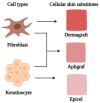Synergistic Effect of Biomaterial and Stem Cell for Skin Tissue Engineering in Cutaneous Wound Healing: A Concise Review
- PMID: 34065898
- PMCID: PMC8150744
- DOI: 10.3390/polym13101546
Synergistic Effect of Biomaterial and Stem Cell for Skin Tissue Engineering in Cutaneous Wound Healing: A Concise Review
Abstract
Skin tissue engineering has made remarkable progress in wound healing treatment with the advent of newer fabrication strategies using natural/synthetic polymers and stem cells. Stem cell therapy is used to treat a wide range of injuries and degenerative diseases of the skin. Nevertheless, many related studies demonstrated modest improvement in organ functions due to the low survival rate of transplanted cells at the targeted injured area. Thus, incorporating stem cells into biomaterial offer niches to transplanted stem cells, enhancing their delivery and therapeutic effects. Currently, through the skin tissue engineering approach, many attempts have employed biomaterials as a platform to improve the engraftment of implanted cells and facilitate the function of exogenous cells by mimicking the tissue microenvironment. This review aims to identify the limitations of stem cell therapy in wound healing treatment and potentially highlight how the use of various biomaterials can enhance the therapeutic efficiency of stem cells in tissue regeneration post-implantation. Moreover, the review discusses the combined effects of stem cells and biomaterials in in vitro and in vivo settings followed by identifying the key factors contributing to the treatment outcomes. Apart from stem cells and biomaterials, the role of growth factors and other cellular substitutes used in effective wound healing treatment has been mentioned. In conclusion, the synergistic effect of biomaterials and stem cells provided significant effectiveness in therapeutic outcomes mainly in wound healing improvement.
Keywords: natural/synthetic biomaterials; skin regeneration; stem cells; tissue engineering; wound healing.
Conflict of interest statement
The authors declare that the research was conducted in the absence of any commercial or financial relationships that could be construed as a potential conflict of interest.
Figures




Similar articles
-
Polymeric biomaterials-based tissue engineering for wound healing: a systemic review.Burns Trauma. 2023 Feb 7;11:tkac058. doi: 10.1093/burnst/tkac058. eCollection 2023. Burns Trauma. 2023. PMID: 36761088 Free PMC article.
-
Tissue Engineered Skin and Wound Healing: Current Strategies and Future Directions.Curr Pharm Des. 2017;23(24):3455-3482. doi: 10.2174/1381612823666170526094606. Curr Pharm Des. 2017. PMID: 28552069 Review.
-
Silk biomaterials in wound healing and skin regeneration therapeutics: From bench to bedside.Acta Biomater. 2020 Feb;103:24-51. doi: 10.1016/j.actbio.2019.11.050. Epub 2019 Dec 2. Acta Biomater. 2020. PMID: 31805409 Review.
-
Combined chemical and structural signals of biomaterials synergistically activate cell-cell communications for improving tissue regeneration.Acta Biomater. 2017 Jun;55:249-261. doi: 10.1016/j.actbio.2017.03.056. Epub 2017 Apr 2. Acta Biomater. 2017. PMID: 28377306
-
Combination Therapy of Stem Cell-derived Exosomes and Biomaterials in the Wound Healing.Stem Cell Rev Rep. 2022 Aug;18(6):1892-1911. doi: 10.1007/s12015-021-10309-5. Epub 2022 Jan 26. Stem Cell Rev Rep. 2022. PMID: 35080745 Review.
Cited by
-
Silk Sericin: A Promising Sustainable Biomaterial for Biomedical and Pharmaceutical Applications.Polymers (Basel). 2022 Nov 15;14(22):4931. doi: 10.3390/polym14224931. Polymers (Basel). 2022. PMID: 36433058 Free PMC article. Review.
-
Wound Healing with Electrical Stimulation Technologies: A Review.Polymers (Basel). 2021 Nov 1;13(21):3790. doi: 10.3390/polym13213790. Polymers (Basel). 2021. PMID: 34771347 Free PMC article. Review.
-
3D-bioprinted human lipoaspirate-derived cell-laden skin constructs for healing of full-thickness skin defects.Int J Bioprint. 2023 Mar 23;9(4):718. doi: 10.18063/ijb.718. eCollection 2023. Int J Bioprint. 2023. PMID: 37323499 Free PMC article.
-
Advancing Spinal Cord Injury Treatment through Stem Cell Therapy: A Comprehensive Review of Cell Types, Challenges, and Emerging Technologies in Regenerative Medicine.Int J Mol Sci. 2023 Sep 20;24(18):14349. doi: 10.3390/ijms241814349. Int J Mol Sci. 2023. PMID: 37762654 Free PMC article. Review.
-
Enhancement of Wound Healing and Angiogenesis Using Mouse Embryo Fibroblasts Loaded in Decellularized Skin Scaffold.Iran Biomed J. 2024 Mar 1;28(2&3):90-101. doi: 10.61186/ibj.3971. Iran Biomed J. 2024. PMID: 38770915 Free PMC article.
References
Publication types
Grants and funding
LinkOut - more resources
Full Text Sources
Other Literature Sources

